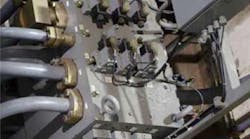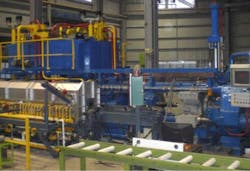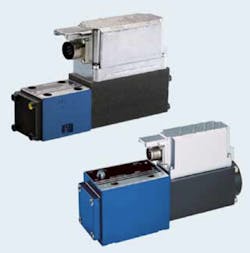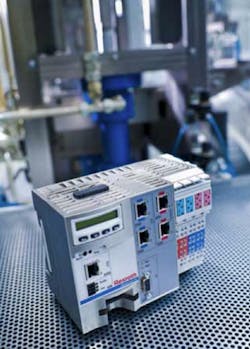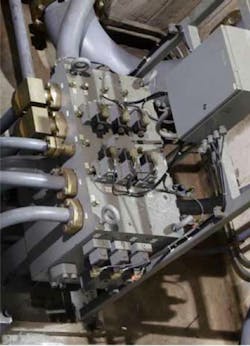Hydraulic Upgrade Brings New Life to Extrusion Press
Aluminum parts producers are carefully assessing the performance of their extrusion presses as customers such as vehicle component manufacturers, aerospace suppliers, window and door (fenestration) suppliers and other high-volume users seek faster turnarounds and smaller order lot sizes. Customers are also requiring more complex profiles and extrusions with lowered costs.
These industry conditions, along with consolidation among aluminum shapes suppliers, are creating greater operational demands on presses. When parts makers consolidate, they typically move work onto one press and maximize its use, which can strain the machine, particularly an older press.
Although some parts producers may feel compelled to completely replace an old extrusion press to keep up with production demands, this major investment may not be necessary. If the press frame is sound, a retrofit and upgrade of key press components, such as hydraulics and controls, can extend the life of the press and provide a more flexible, reliable and productive long-term solution.
Retrofits offer advantages for long-term value
|
Extrusion Press Retrofits: Five Factors to Consider • If your press uses limit-switch or analog controls, greater extrusion velocity accuracy and better butt control is possible with newer digital electrohydraulic controls • Consider hydraulics efficiency and reliability—if your hydraulics platform has servo valves or inline valves, lower cost proportional valves and press control manifolds can be used to simplify system design, reduce leak points and improve pump efficiency • Energy efficiency can be improved by retrofitting with more efficient hydraulic pumps and motors • Consider working conditions— safety, environmental hazards from leaking hydraulics, excess noise. A retrofit of aging or inefficient hydraulics and controls can help pay for itself by significantly reducing these costs • Analyze the “dead cycle” when the press isn’t producing parts. Retrofits can often increase press availability and throughput by up to one part per minute—justifying the investment in new hydraulics or controls. |
The cost of a new high-capacity aluminum extrusion press may cost $2 million or more depending on the capacity (plus installation costs); whereas the cost for a typical total retrofit may only be half the cost of the press.
In retrofits, the hydraulics and controls components and systems are analyzed to identify opportunities where more efficient, latest-generation technologies can improve performance. These include controls such as the latest in proven programmable logic controllers (PLCs) and human machine interfaces (HMIs), closed-loop controllers and hydraulics systems such as the pumping station, valves (including in-line and manifolds) and the interconnected piping.
The benefits of a retrofit include:
• minimal system disruptions
and downtime,
• longer operational life of major
(i.e., costly) press components such as the press frame,
• greater throughput, improved troubleshooting and increased parts precision, and
• improved operating conditions and easier maintenance.
Each press operation is unique, and the life and operational performance of a press can greatly vary. Therefore, when considering a hydraulics and controls systems retrofit, evaluate these factors to determine the ultimate scope and return of a press retrofit project.
Factor One: current level of extrusion control
Consider your current level of extrusion control: How precise is it? What is the scrap rate? How much time and effort does it take to achieve high-quality, low-defect parts consistently, without added operator intervention? If the output of your press must be scrapped due to unacceptable quality, then it may need better electrohydraulic controls.
Many existing extrusion presses utilize limit switches or analog controls to manage hydraulic cycles in the press. These legacy systems could be limiting productivity and adding to waste. Today’s state-of-the-art PLCs and closed-loop pump controllers provide much finer accuracy, whether operators are using press velocity or part temperature to manage extrusion throughput. An improved control system architecture provides greatly enhanced precision and automation of the hydraulics circuit, achieving much higher levels of position, velocity and endpoint control. These controls also allow adjustments during the extrusion cycle to keep production moving. Increased extrusion precision also leads to greater control over but length, helping reduce aluminum waste and increase the number of shapes produced per hour.
This does not mean that you can ignore filtration; filtration is one of the most important elements in helping a system to survive for years. In this example, if the pump control valves are not as rugged as they could be, or require persistent maintenance leading to press downtime, a retrofit incorporating proportional valves may reduce operational costs.
Hydraulic systems also can be simplified (and thus easier to operate and maintain) by replacing inline valve architectures with a single hydraulic manifold. This rationalizes the hydraulic design, reduces the leak points and hydraulic maintenance requirements and also can reduce the number of spare parts that must be stocked to keep the press operating.
Factor Two: hydraulics efficiency and effectiveness
Assess the efficiency and reliability of your hydraulics and controls systems components. You may be using less efficient, more problematic components that are actually reducing productivity. For example, many older-generation presses have servo valves to control the hydraulic pumps and the speed of the press. The servo valves are typically expensive, and require hydraulic fluid that has a dedicated filtration system with finer particulate removal than that of the existing filtration system; if the filter degrades through use, or the filtration systems are not continually maintained, the servo valves clog easily and can disrupt extrusion.
In contrast, the current generation of proportional hydraulic valves can provide the same (and sometimes better) functionality in the hydraulic circuit, yet are much more tolerant of variations in hydraulic fluid quality. This does not mean that you can ignore filtration; filtration is one of the most important elements in helping a system to survive for years. In this example, if the pump control valves are not as rugged as they could be, or require persistent maintenance leading to press downtime, a retrofit incorporating proportional valves may reduce operational costs.
Hydraulic systems also can be simplified (and thus easier to operate and maintain) by replacing inline valve architectures with a single hydraulic manifold. This rationalizes the hydraulic design, reduces the leak points and hydraulic maintenance requirements and also can reduce the number of spare parts that must be stocked to keep the press operating.
Factor Three: energy efficiency
Another challenge for aluminum extruders is to reduce the amount of energy expended in powering the press hydraulics without sacrificing productivity.
One retrofit opportunity in this area is to evaluate the electric motor driving the hydraulics pump. In many older systems, these motors tended to be oversized to compensate for inefficiencies downstream in the hydraulics system (leaks, pressure drop-offs, etc.). New regulations, such as the Energy Independence and Security Act of 2007 (EISA 2007), call for “right-sizing” manufacturing systems with the use of more energy- efficient motors.
These motors can be utilized in conjunction with a systems design concept called “energy on demand,” which integrates sophisticated controllers and variable speed pumps with properly sized electric motors to deliver only as much energy as is needed to accomplish the press cycle.
Hydraulic pump efficiency is also worth assessing for a retrofit. All hydraulic pumps utilize a portion of the fluid flowing through them for lubrication. To generate the required force in a hydraulic motion sequence, more energy needs to be drawn from the electric motor powering the pump to compensate for this fluid, since it is not actually contributing force to the press ram. Less efficient, older-generation pumps require more lubrication. They also generate higher levels of waste heat which adds more loads on the cooling systems and can lead to unnecessary energy consumption.
The latest generation of hydraulic pumps is more efficient and requires less lubrication and places lower loads on the cooling system, which in turn can provide significant energy savings. Newer generation pumps also feature integrated sensors and diagnostic ports to check hydraulic system pressure.
Factor Four: working environment
Safety for the machine operator and protection for the press itself have become more significant in today’s manufacturing environment. Older presses may not handle the safety aspects of a press as well as new control systems. For example, new systems can set unique upper limits on pressure for each die in the press to help protect the die (and other press components) from damage. Upgrading to controls with these capabilities can enhance plant safety and lengthen the life of your equipment.
Two other complaints associated with extrusion press hydraulics are fluid leaks and noise. Hydraulic leaks create hazards such as slippery floors, dirt, even fire risks. Plus, persistent leaks require more frequent and costly refilling of the hydraulic fluid reservoir. Much of the noise typically associated with hydraulic presses comes from the high-power electric motor driving pumps, as well as the pumps themselves.
It’s often assumed that these issues are inherent to the power and force dynamics that only hydraulics can deliver—even if it means increased maintenance and an unsuitable operating environment.
Many of these issues arise from outdated or poorly designed and/or maintained hydraulics systems—and can be easily resolved through a retrofit. For example: presses that utilize older inline valves have far more seals and points where leaks can occur than systems retrofitted with hydraulic manifolds.
In addition, limited control system design, or older controllers, may be introducing high levels of hydraulic “shock” through the press motion cycle, overstressing valves and seals. Newer electrohydraulic controls offer much finer control of the hydraulic axis, minimizing stress on the system. To reduce noise, simple enclosures of pumps and motors, or reorienting motor-pump assemblies to redirect noise, can resolve excess noise issues with minimal cost as part of an intelligently designed and cost effective retrofit.
Factor Five: overall operating costs
Many press operators incrementally expend time and resources on repeated repairs and maintenance efforts. These include maintaining spare parts inventories, repair and service contracts with outside hydraulics and controls service providers, and more frequent maintenance cycles—all of which can also reduce press availability. The costs are not just related to time and materials, but also to opportunity costs. There is more risk of losing potential business with less efficient or problem-prone extrusion operations. A new press would alleviate these issues, but these problems could be solved with significantly less cost through a retrofit.
A key goal is also to reduce the extrusion press “dead cycle,” or the time when the press is not extruding parts. A hydraulics and controls retrofit has the potential to directly reduce the extrusion press dead cycle.
New life for extrusion pressess
Preserving and extending the value of existing manufacturing equipment makes fundamental sense; the challenge is to determine which solution offers the most reliable and measurable return on investment. The age and performance of your existing systems needs to be analyzed. Although no one factor can solely justify a significant retrofit, it makes sense to consider all aspects of the systems that affect extrusion press performance, uptime and part quality.
It also makes sense to consult with experts who have in-depth experience designing high-efficiency hydraulics and controls solutions for both new extrusion presses and retrofit/ upgrade projects. You may discover inefficiencies in your production platform that can be addressed through a cost-efficient retrofit.
Jeff Grube is Manager, Press and Heavy Industry, Bosch Rexroth, Charlotte, N. C. For more information, visit www.boschrexroth-us.com.
